The Polynesians observed this, and regarded the stars as ‘fingers’ pointing down to the earth and always passing over the same places and the earth revolved beneath them.
With the aid of the star map, it is easy to find and identify any star almost directly overhead. It may be slightly North or South but should not be East or West.
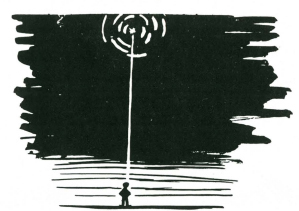
To find a point directly overhead, stand upright, with your head thrown well back. Rotate the body through a series of half circles and you will see the stars overhead appear to move in arcs.
The centre of the circle which the arcs form will be the point in the sky directly over your head.
Having recognised the overhead star from your Star Map, work out its right ascension, and add two hours for every month, or half an hour a week and four minutes for every odd day till the next September 21st, and add this to the time of Right Ascension.
Example. The star Amares, the very bright star in the Scorpion, you read as 16 hours 25 minutes Right Ascension. The date if it is overhead is March 25th. From March 25th to September 21st there are five months, three weeks and four days, which equal a correction of 11 hours 46 minutes. This added to the right ascension of 16 hours 25 minutes gives a total of 28 hours 11 minutes. Because the total is greater than the twenty-four hours you must deduct the twenty-four hours and the result is 4 hours 11 minutes (a.m.) Greenwich. To this you must make correction for your longitude.
This method is applicable in all latitudes and gives reasonable accuracy.
TIME FROM THE STARS—NORTHERN HEMISPHERE
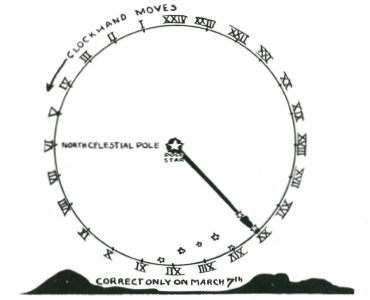
In the Northern Hemisphere the stars appear to revolve anti-clockwise in the sky, and you must remember this when reading time from the stars at night. Imagine the Pole star (Polaris) is the centre of a twenty-four-hour clock dial, and the hours are numbered from Midnight 24 hours, anticlockwise with 6 hours at the left and horizontal with the Pole star, twelve o'clock immediately below the Pole star, and eighteen hours at the right, horizontal to the Pole star. The brightest stars, Alpha and Beta, in Ursa Major (opposite the handle of the Big Dipper) or plough are the hour hands.
It gives correct time only on one day in the year, March 7th, thereafter it gains 4 minutes a day, or two hours a month, so that if it reads fifteen hours on June 1st, it will be seven and a half hours fast and the correct time therefore will be 7 hours 30 minutes.
SOUTHERN HEMISPHERE
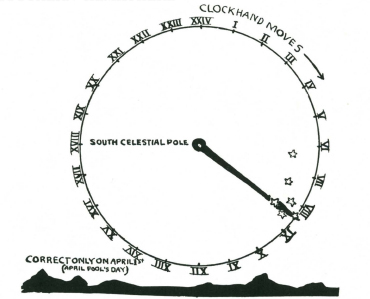
In the Southern Hemisphere the stars appear to revolve clockwise. The Southern Cross is the hour hand of a twenty-four-hour Sky Clock, and the centre of the dial is four and a half times the length of the Cross towards the foot along the longest axis of the Cross. This clock is correct on April 1st (April Fools' Day—just to fool you, but don't be fooled), and thereafter it gains at the rate of 4 minutes a day or two hours a month, so that if it reads 8.20 on September 1st it will be ten hours fast, and therefore the correct time will be 22 hours 20 minutes, or 20 minutes past ten at night.
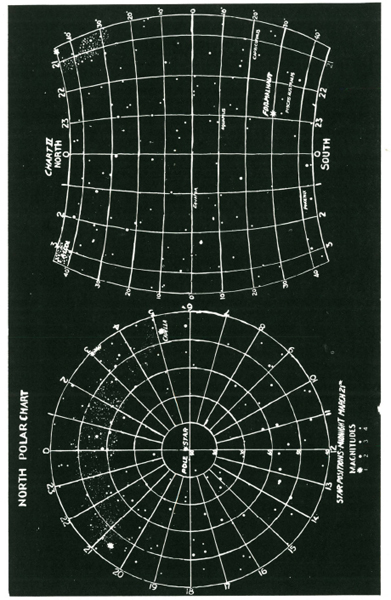
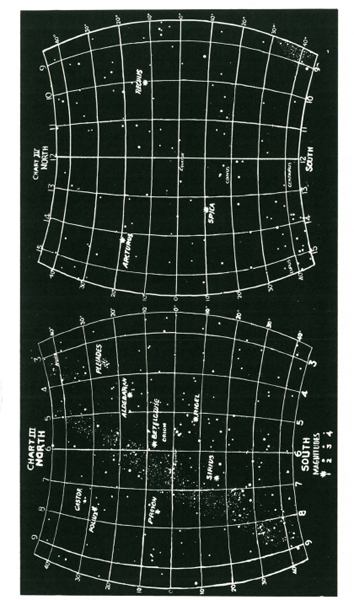
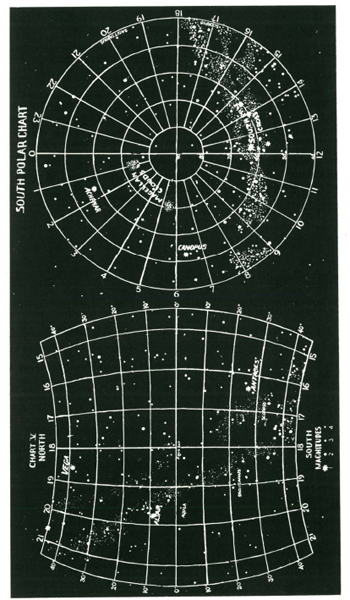
DIRECTION FROM THE STARS
In the Northern Hemisphere, direction from the stars is easy. Polaris, the Pole Star, is very nearly directly over the North Pole, and therefore wherever you see it .in the sky is true North.
In the Southern Hemisphere there is no star over the South Pole and finding direction is a little more difficult.
One of the most popular methods is from the constellation CRUX, or the CROSS, better known as the Southern Cross. There are many stars which appear to make the shape of a cross in the sky, and therefore it is essential, if you live in the Southern Hemisphere, that you learn to identify the Southern Cross beyond any shadow of doubt.
Look along the Milky Way, which is unmistakable, and you will find a dark patch without a single star. This is commonly called the Coal Sack, and the Southern Cross lies right on the very edge of the Coal Sack.
To make identification more certain, the Southern Cross should show you five stars, the fifth less bright than the others, and nearly in line with the foot star, and one of the arms. Another certain identification is the two pointers, two stars of the first magnitude, lying always to the left-hand side of the Cross (when viewed as if the Cross was in a vertical position).
The longest axis of the Cross towards the foot points to the Celestial South Pole. That is, to a position over the earthly South Pole.
This, using the length of the Cross from head to foot, is almost exactly four and a half times the length of the Cross commencing from the foot.
You can measure this with fair accuracy by holding the hand at arm’s length, and using the thumb and forefinger as a pair of calipers to measure the length of the Cross.
Another indicator of true South, suitable for moonless nights is the two Magellan Clouds, which form the base of an imaginary equal-sided triangle, the apex of which is over the South Pole. On bright nights, when these two clouds are not visible, the two very bright stars, Achenar and Canopus, also are the base of an equal-sided triangle with its apex over the South Pole.
THE SUN COMPASS
A Sun Compass is far quicker to read and very much more convenient than having to refer to a magnetic compass. The directions for working out a Sun Compass are suitable for either working out on a card, on the ground, or, if you prefer it, for drawing on some unimportant area of your map.
On a map, a Sun Compass has marked military value.
A Sun Compass worked out on the ground in a camp becomes a Sun Clock, accurate to a minute if set down correctly.
First draw a circle (if on the map on a place where important information will not be obliterated) or if on the ground the area must be clean and level and open to sunshine throughout the day.
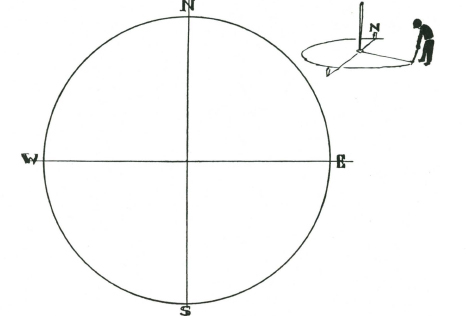
The first stage of working out a SUJI Compass.
The size of the circle does not matter, six or seven inches on the map, two or three if for a card, three or four or even six feet if on the ground.
Work out carefully and accurately the true North line.
It is vitally important to have this most accurate.
If your Sun Compass or Sun Clock is wrong, it is because you have not put this North line in accurately.
If on a map this accurate North-south line will be either shown on the grid, or by the NORTH arrow head. Make sure that it is TRUE North, not magnetic.
When you have this line drawn from North to South, through the centre of the circle, draw another also through the centre from East to West, and divide the outer circumference of the circle into twenty-four equal divisions. Each of these divisions will be exactly fifteen degrees.
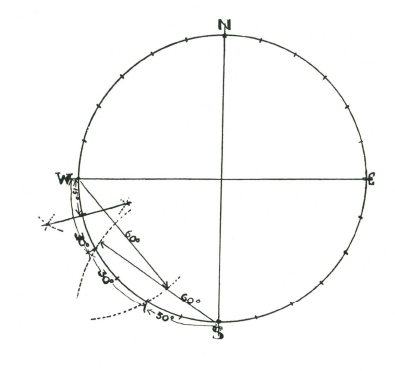
These fifteen-degree divisions can be either marked off, if on a card, with a protractor, or if on the ground by using the cord for the radius of the circle, which will divide the circle into sixty-degree divisions from the North-south points of intersection, and into thirty degree divisions from the East-west intersections.
These thirty-degree divisions are bisected, and as a result you have the necessary twenty-four divisions of fifteen degrees each.